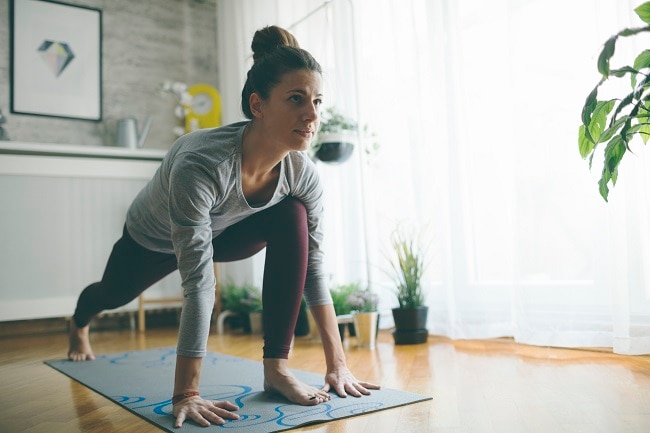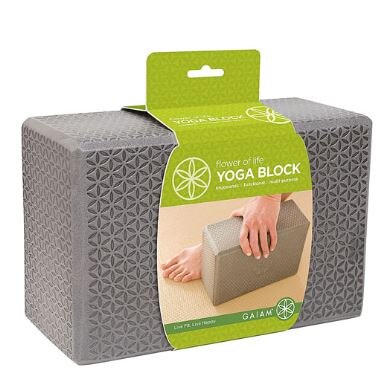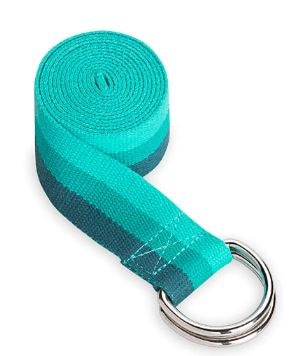If you have a rigid schedule or aren’t keen on venturing out, practicing yoga at home is a legit alternative to taking classes. In fact, even if you already practice in a group, a personal practice – meaning you guide yourself, no instructor needed – can foster deeper growth.
If you’re not familiar with yoga, a basic sense of it will help. Avoid blindly searching the internet; there’s no telling whether videos or websites you pull up will offer constructive information. Be smart. One of the best online (and print) resources, with vast information on many yoga styles and philosophies, is Yoga Journal. Full disclosure: I’m a contributing editor and was a staff editor – but plug “yoga” into Google and it’s one of the first links that pops up. It also has been around for nearly half a century and relies on the knowledge of master teachers.
Now you can pick your path:
Exploration of you on your own
Yoga isn’t brain surgery. It’s incredibly intuitive, be it the physical side or the practice’s meditation aspects, along with its underlying tenets. This isn’t to say you can always pinpoint problematic physical issues on your own – and you definitely don’t want those bleeding into your physical practice. But if you have a decent understanding of biomechanics, muscles, tendons, ligaments and joints, you can create your own gentle practice (more advanced practice will likely take tutelage). It’s called Calisthenics Combined with Stretching & Balancing, While Breathing Deeply & Paying Attention. That’s also the sum of what you do when you practice yoga postures.
1. Online classes
Be sure online classes or apps use qualified instructors. Gaia and YogaGlo are excellent choices. Remote classes can be pre-recorded or live. Start with beginner and gentle versions. Many fabulous teachers offer online instruction, but it’s probably better to start with the comprehensive websites in order to first get a sense for various teachers.
2. Media
Most (though not all) books and DVDs from decent publishers feature good instructors. Excellent videos to start: slow flow and restorative options from Jillian Pransky. And an excellent book whether you’re young, old, fat or skinny (don’t let the title throw you): Relax into Yoga for Seniors by Kimberly Carson and Carol Krucoff.
3. Private instruction
This option won’t immediately drop you into a personal practice, but it’s more likely to put you on a path to it than group instruction would. It’s also going to be more expensive than other options. But if you work one-on-one with a qualified teacher (which is how folks learned yoga many moons ago), you can home in on what’s best for you, specifically. An instructor who knows a lot about anatomy can point out muscle imbalances or the like and eventually guide you toward advanced practice. If you’re more keen on learning about other aspects of yoga – meditation, for example – one-on-one guidance from an expert in that arm is invaluable, too.
To find an instructor, check local yoga studios or hunt for recommendations. Generally the more hours a teacher has studied or practiced, the better. Yoga Alliance, the largest non-profit organization that keeps tabs on yoga, lists many teachers who have gone through training programs registered with it. But this does not mean that every teacher who has gone through a yoga training is knowledgeable. Also, plenty of knowledgeable teachers won’t be listed simply because they didn’t pay fees in order to be or never went through a “teacher-training,” per se.
Once you’ve picked your path, some goods will be helpful.
Yoga mat
A rubber mat is a home for your practice, a physical representation of it, which means it gets you in the proper head space. Also, the mat’s outline helps orient you in space, which aids in alignment. Finally, its stickiness stops you from sliding, and its depth cushions you. But if you don’t have a mat, you can still do reclined postures in a bed or on carpeting, and do standing poses on a floor.
Yoga blocks
Two blocks, one for each hand, adapt postures for your body. Can’t reach the floor with your fingers? Put blocks under your mitts. Not flexible enough for a backbend? Prop yourself up with blocks. You get the idea. No household item can substitute for light, foam blocks. If you prefer heavy, cork blocks (I don’t; they’re too hard) you might find some things that do.
Yoga strap
You need only one. Same premise as with blocks; a strap helps you reach body parts you couldn’t otherwise. You certainly could sub a tie for a strap, though it’ll be slippery and you won’t be able to buckle it in order to create loops.
Journalist and yoga teacher Mitra Malek regularly edits and creates content for wellness-focused outlets, including Yoga Journal, for which she is a contributing editor. Learn more at mitramalek.com.




